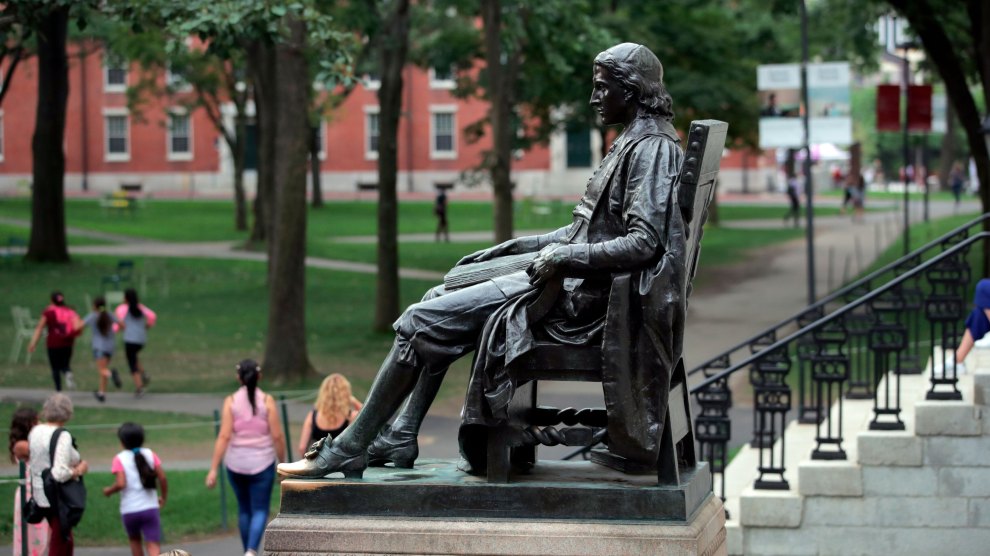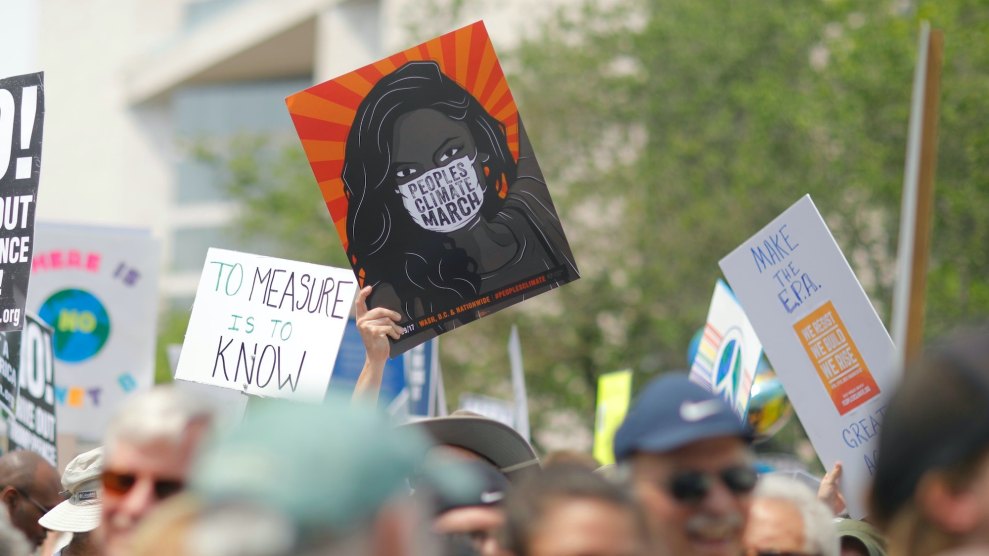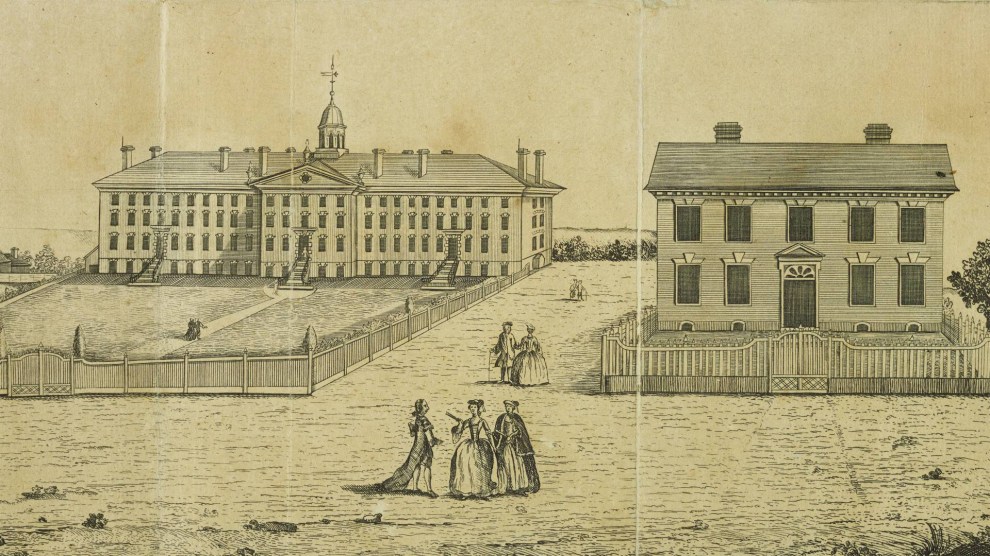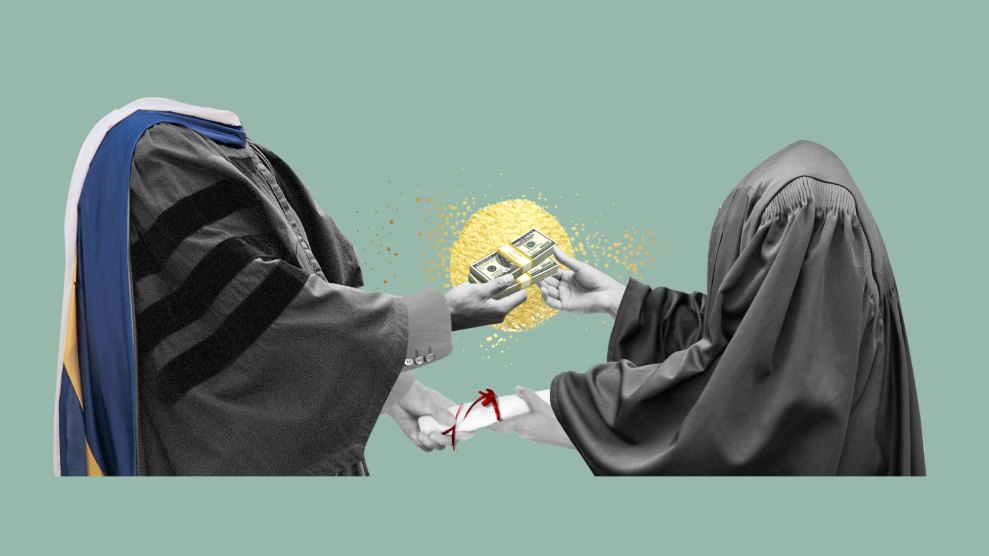
A statue of college founder John Harvard in Harvard Yard, Cambridge, Mass.Charles Krupa/AP
As a UC Berkeley graduate, I never thought I’d type these words, but okay: Go Wesleyan!
Wesleyan University, a small, elite college in Middletown, Connecticut, costs about $85,000 a year, including room and board and sundries. On Wednesday, it announced that, in the wake of the recent Supreme Court decision ending race-based affirmative action in higher education (and possibly elsewhere), it would finally ditch legacy admissions, the practice of giving a preference to applicants whose parents—and in some cases grandparents, siblings, and other relatives—attended the school in question. It’s a practice that amounts to affirmative action for children of privilege.
Johns Hopkins and Amherst also ended legacy admissions in recent years, and MIT ditched them more than a decade ago. (“If you got into MIT, it’s because you got into MIT. Simple as that,” one admissions staffer noted in a 2012 blog post.) But all of the Ivy League colleges, and the majority of so-called Ivy Plus schools (the traditional Ivies plus the likes of Duke, MIT, and Stanford) still use them. In fact, a 2018 survey of admissions directors by Inside Higher Ed found that 42 percent of private colleges and 6 percent of public ones gave an admissions boost to children of alumni, and sometimes to grandchildren and siblings. Children of faculty may also get special consideration, as they do at Harvard.
Legacy admissions, if it even need be said, are unfair, unpopular, and un-American—or at least run contrary to the ideals of the America we mythologize. I poked that alligator in an earlier piece about how the Ivies are grappling with their slavery ties. And whatever you think of affirmative action, legacy admissions look even less fair when you outlaw preferences for underrepresented minority applicants. That’s because the history of racial exclusion in US higher education ensures that the legacy admits at most elite schools, deserving or not, are dominated by well-off white kids. From that earlier piece:
For the classes of 2000 through 2019, Harvard’s average legacy acceptance rate was about 34 percent, compared with 6 percent for non-legacies, according to an analysis commissioned by an (ironically) anti-affirmative action group that is challenging Harvard’s admissions policies in court. At Stanford, the legacy admissions rate is about three times the non-legacy rate. At Dartmouth, which also has legacy admissions, 15 percent of the class of 2025 are children of alumni.
The Daily Princetonian, Princeton’s campus paper, reported that just 2 percent of the 35,370 students applying for the class of 2022 were legacies, but nearly one-third of them were accepted. That’s compared with an overall admissions rate of 5.5 percent, 6.2 percent for students of color. The resulting class was more than 14 percent legacy students. In his 2016 book, The Price of Admission, Pulitzer Prize-winning journalist Daniel Golden wrote that elite private colleges, as a condition of their tax-exempt status, are prohibited from engaging in racial discrimination, yet the legacies who suck up slots at the expense of other qualified students are overwhelmingly wealthy and white.
- Approximately 18.8 percent of surveyed white students reported legacy status, compared to 6.1 percent among African American or Black freshmen, 9.1 percent among Hispanic or Latinx students, and 15.1 percent among Asian students.
- On average, legacy students reported a higher family income than that of their non-legacy classmates. Roughly 30.9 percent of legacy students reported a combined parental income of more than $500,000. Only 12.6 percent of non-legacy students said the same.
Why do legacies persist? The optics, after all, are atrocious. “Back in the old days,” Matt Feeney wrote in the New Yorker after Amherst ended legacy admissions in 2021, “the rich kids probably liked having a few smart kids from the lower classes around, or at least conceded that they were necessary. The raw bookishness of the smart kids ratified the larger enterprise that they were all participating in—it was a college, after all. But now that the aristocrats are siphoning status from the meritocrats, the social bargain is starting to look like a bad one.”
Worse than legacy admissions—or better, depending on your perch—is the dean’s interest list. That’s the list applicants get on when their extraordinarily wealthy parents pledge major gifts to the college. (Jared Kushner, who attended Harvard, was likely on just such a list.) As I point out in my 2021 book on runaway wealth in America, an expert witness in the case that ended affirmative action found that the average acceptance rate for Harvard dean’s listers for the 2014 through 2019 admissions cycles was 42 percent—seven times the overall acceptance rate.
One wealthy source I interviewed told me he had no problem with that. The gift of a new building—or whatever—benefits students of all backgrounds, he said. If a few pampered rich kids get some extra hand-holding, so what? He may have been right from a purely utilitarian perspective, but from an equity perspective, letting a rich family buy its way into a super-exclusive college—Harvard’s Class of 2025 acceptance rate was a mere 3.4 percent—is an abomination. (Never mind that the same guy told me financially successful people are that way because of their genes. Social Darwinism lives!)
Another common rationale for legacy admissions is the belief that it keeps alumni close and willing to give money to their alma mater. “It’s never easy to turn away the children of Dartmouth alumni,” the school’s dean of admissions wrote in a 2011 article in the alumni magazine, after conceding that legacy applicants were admitted at about two-and-a-half times the overall rate.
But the donor calculus may be spurious. The MIT blogger cited very similar donation levels for MIT when it still allowed legacies and Caltech, which did not. “Research suggests that favoring legacies either increases donations marginally or has no effect,” Feeney writes in the New Yorker. “Besides, Amherst, a school with fewer than two thousand students, has an endowment of almost four billion dollars. For a school with two million dollars of endowment per student, taking a small hit in alumni donations in exchange for this singular boon of institutional marketing seems not just a feasible move but a clever one.”
So maybe we should be putting more heat on that Ivy League college whose endowment was almost $52 billion at the end of the first quarter of 2023, more than the GDPs of most nations. Couldn’t this vaunted institution (which gave me a full ride for graduate school) afford to end legacy admissions? Just think, Harvard would get major credit for being the first of the Ivies to do so.
If it needs a nudge, Congress might even consider eliminating the tax-exempt status of schools with vast endowments that refuse to end affirmative action for the rich. Such a proposal would probably never pass, though. Because Congress is yet another institution where the kind of people who support—and count on—legacy admissions have a lot more sway than they rightly deserve.
Correction (7/20/2023): An earlier version of this story misstated the time period for which an expert witness calculated Harvard’s “dean’s list” acceptance rate. The 42 percent rate is an average from Harvard’s 2014 through 2019 admissions cycles.

















